Quick Presentation

USS Galena, USN archives (cc)
- CSS David (1862)
- CSS Frederickburg (1862)
- CSS Savannah (1863)
- CSS Stonewall/Kōtetsu/Azuma (1864)
- HL Hunley (1863)
- Unadilla class gunboats (1861)
- USS Alligator (1862)
- USS Keokuk (1862)
- USS Monitor (1862)
- USS New Ironsides (1862)
- USS Spuyten Duyvil (1864)
Ten years after the Crimean War, another bloodbath awaited a nation still barely out of its independence and still conquering new lands, with already a burgeoning industry confined in the northeast of the continent. It will be in terms of naval matters also rich with the invention of the Monitor, a variation on the theme of armored riverine warfare, but also introducing modern rifled guns and breech-loaded, shells, mines, spar torpedoes and submersibles.
The conflict is rooted in strong economic, industrial and cultural differences and disparities between North and South. The tension rose about slavery, which was the major sticking point between these states, as the Industrial north did not need it (but freed workforce) and pushed for abolition, while the agricultural South was totally dependent of its perpetuation.
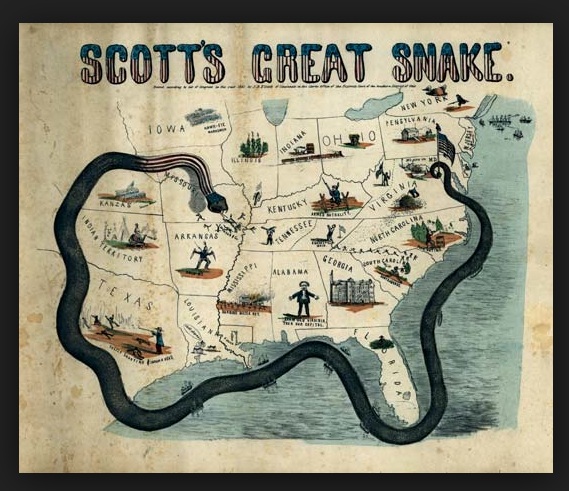
“Scott’s great snake, the anaconda plan, naval blocus of the confederacy
New legislation in the North (abolitionist states now have the majority in Congress) were perceived by southern states as a future threat to slavery. More importantly, with the election of Abraham Lincoln in 1860, also hostile to slavery, Southern states eventually decided to withdraw from the Federation, led by Jefferson Davis. However, if the disparity of resources is overwhelming, the south has brilliant officers (as Robert E. Lee) and sheer determination against the Union to save their own way of life.
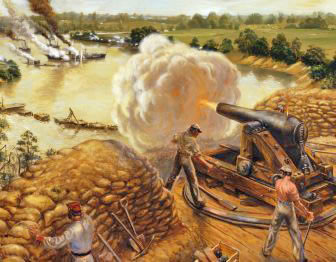
The confederation was formed of seven states (South Carolina, Texas, Louisiana, Alabama, Mississippi, Florida, Georgia) while bordering states being torn apart and a wall of hate raised since the declaration of Lincoln calling it illegal secession. Soon after that, and also facing foreign delegations, the Confederacy was assimilated to a rebellion by the north, hence the name “secession war” and the Union objective to reunify all states.
The hostilities 1861-65

Fort Sumter bombardment. It was the very opening of the four years event that turned a young growing nation apart.
While attempting to resupply Fort Sumter, a Federal garrison in South Carolina, the Union troops were fired upon by the Confederacy and later an artillery siege began and later the fort pounded until the garrison surrendered. War broke out this April 12, 1861. The Southern officers, heirs to a long military tradition proved more likely to train their troops that the North, which began badly: At the battle of Bull Run, the Union troops were defeated by those of General Beauregard. The North, however, managed to be a “glaze” with border states, which stayed until then very mixed, or neutral.
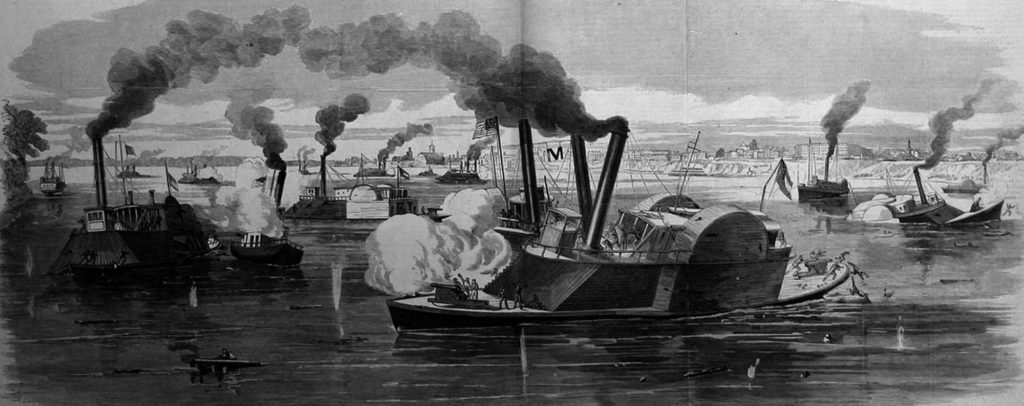
The Union would suffer a second defeat in the “battle of seven days” in the east, and then occurred the second battle of Bull Run led this time by Lee, who drove the Union in the North, marching on Washington. Aware of the seriousness of the situation, the North threw all its strength to Antietam (September 17, 1862). Losses were appealing on both sides, forcing Lee to retreat temporarily. In December 1862, troops of Gen. Burnside tried to take the fortified positions of Lee in Virginia and at Fredericksburg, without success.
From mid-62, the Union general Ulysses S. Grant success as making a breakthrough on the Mississippi River cut the Confederacy in two. Late 1862, he stumbled on Vicksburg strongpoint, which was devastated after a punishing artillery siege. To the east, in May 1863, Lee defeated the Union again at Chancellorsville. But it was a pyrrhic, costly victory, where he lost many men including his best general, Stonewall Jackson. He crossed Pennsylvania and met the Union forces at Gettysburg in July 1863, the turning point of the war.
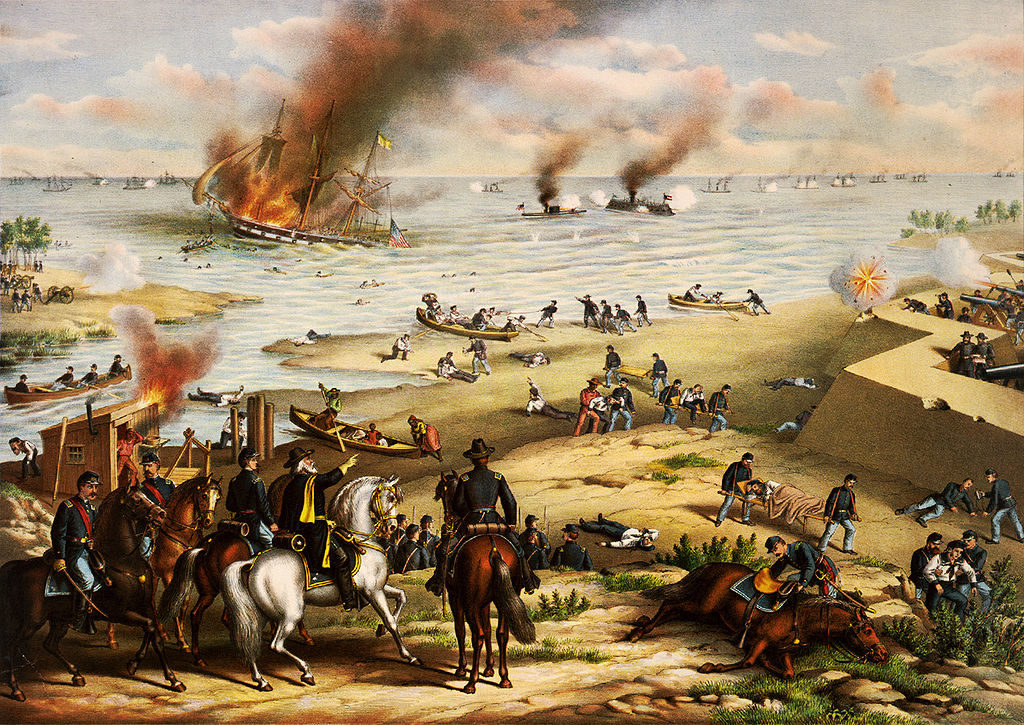
The battle of Hampton Roads, the first ironclad fight
This was his first defeat, and he blamed himself in face of his men to have underestimated the union defense. The Union at the same time, guaranteed itself sturdy access to southern Mississippi by eventually taking Vicksburg. A new battle, this time with the Confederates in full retreat, was committed near Chattanooga in November. It was a decisive victory for the Union, opening the gates of Alabama and Georgia. At that aspect of riverine warfare is of course what motivated this article.
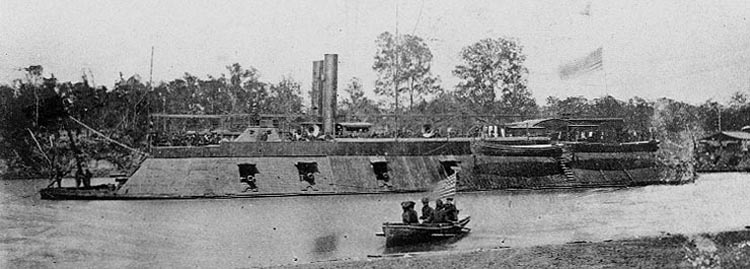
River ironclad USS Pittsburgh, 1861
In 1864, Grant was appointed by Lincoln at the head of Union forces. Assisted by Sheridan and Sherman, he will conduct a major offensive on three fronts, with the aim of Atlanta, Richmond, and to cut off the retreat of Confederate and supplies.
Grant faced Lee and the bulk of the Confederate in the forests of the Wilderness 5 and 6 May 1864, and both sides suffered heavy losses. Grant advanced to Spotsylvania Courthouse, but it was a new bloody stalemate. Meanwhile, in the Shenandoah Valley, Sheridan and Sherman in two successful battles at Atlanta and deprived the South of their main sources of supplies.
The Confederates attempted a daring manoeuver but were finally defeated at Nashville in December. Sherman began a march to the sea in April 1865, seizing the railway line from Richmond.

The CSS Shenandoah was one of the most successful Confederate raider.
Lee was forced to retreat in North Carolina, thinking replenish its forces, but he was surrounded by Grant at Appomattox, and forced to surrender on April 9. Therefore, with their best general made prisoner the confidence of the Southerners was broken, and the entire confederation surrendered shortly after.
Naval warfare of the secession war

Ships bombarding Vicksburg on the James River…
No war has previoulsy seen riverine warfare reach such scale. Ships were used in great tactical and strategic way which are still a reference today for all landmasses crossed by major river systems. The Mississippi, one of the largest and longest rivers in the world, was both a lifeline and a natural frontier, splitting the continent in two but allowing the north to communicate with the south, acting as a lifeline for dozens of major cities. Necessities came to protect ships against artillery with wood and iron plates sandwiches which ultimately led built riverine Ironclads, and then the monitor, a concept which lasted until the second world war.
On the seas, the absolute superiority of the North, in ship and industrial resources, enabled the Union early on to impose a naval blockade while the southerners were largely dependent on its exports to Europe, as a mostly agricultural model.
Similarly, the North opposed the Europeans on behalf of the Union representing the majority of Americans, to build and sell ships to the Confederacy, including ironclads that were even lacking in the North (but the USS New Ironsides).

CSS Atlanta, Confederate river ironclad
The Confederates, in fact, purchased several ships, but none was able to join forces before the end of the conflict. Other diversions to the blockade were tested, including that of “blockade runners” fast ships that were requisitioned and hastily armed with artillery, but also mixed clippers and merchant ships turned into corsairs. The Shenandoah and Alabama were the most famous of these, rampaging the Atlantic and beyond.

USS Keokuk (1862), one of the numerous Union Riverine ironclads
On the other hand, the Confederates sought new and creative ways to break the blockade. They built a serie of riverine ironclads, theoretically invulnerable to the Union frigates volleys, on rivers and at sea, the first and most famous being the Merrimack (ex-Virginia).
After a first succseful sortie she went up the East Coast in 1862 and came running from Norfolk into Hampton Roads. There she was opposed to USS Monitor, the famous “cheesebox on a raft” of the great Ericsson. The duel was epic on several points, as one of the early iconclads contests, showing the artillery was by then inferior to armour. It was confirmed at Lissa in open sea after the war.
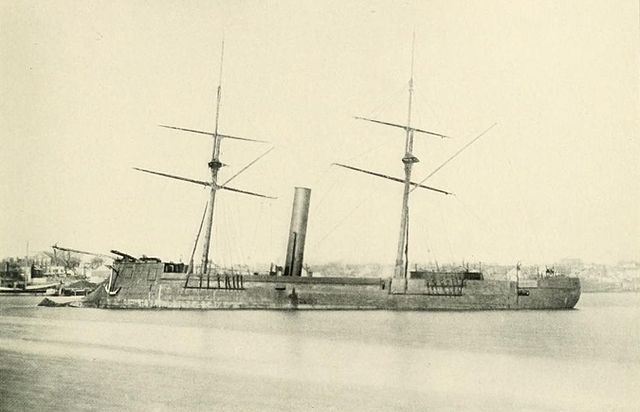
CSS Stonewall, the only sea going Confederate ironclad, built in Bordeaux but never arrived in time to take part in the hostilities. Instead she became the first Japanese ironclad, blooded in the Boshin war.
Many of these riverine ironclads were armed by both sides, as to take control of the rivers was capital, particularly the Mississippi and its tributaries like the James River, ensuring riverine battles with these ships occurred. A desperate situation generated strange vessels like the ram Stonewall Jackson, with its iron and wood turtleback, or the CSS David, a semi-submersible spar torpedo boat, or the HS Hunley, first submarine propelled by human power, were daring avant-garde concepts turned into immediate use. In fact several hand-crack submersibles were built by both sides during the war.
Respective strenght
Nothing shows more the discrepancy between the Confederates and the industrial northern Union than naval might. The immense majority of ships in service by then were located in ports and arsenals remaining firmly in the union’s hands. So much so that its first immediate use was to set up and easily enforce a blockade of the South, preventing any exports and therefore to strangle it economically. The Union was able to maintain a tight netting around 3,500 miles (5,600 km) of Confederate coastline.
And indeed, at large, the blocus was largely successful as the Confederates by all times faced a David vs Goliath contest were only the bold, the daredevils and the innovators thrived. But this was thanks to the will and creativity of Davis’s secretary of the navy, Stephen Mallory. Not only the South created an array of riverine ironclads but also submersibles and spar-torpedo and semi-submerged rams using sloped armour and water protection to a next level, but they also converted all the remaining civilian ships they hold as commerce raiders, forcing the blockade and destroying Union ships along the way to and from Europe, and also purchased from Europe all the ships they could. But he was late to organize commerce raiders and start a closer supervision of blockade-running vessels too late into the war. Until then, the privately owned blockade runners operated on their own.
The effect of the blocus however, plus victory on the Mississippi eventually deprived the Confederate army of its supply bases, armament and resources and ended the conflict. Commanders such as Louis M. Goldsborough and avid Farragut led successful sea-land operations, sometimes combined with troops, to reach their objectives, capturing Port Royal, South Carolina, Roanoke island, New Bern (North Carolina), and later the fall of Savannah and New Orlans. The whole campaign ended with the (difficult) seizure of the last Atlantic port, Wilmington in North Carolina.
In 1865, Lincoln’s navy was 626 warships strong. 65 were ironclads, and they could have dealt with any foreign invasion. From 9,000 seamen in 1861, it ended with 59,000 sailors. Naval appropriations yearly augmented ten times over, to $123 million. This formidable forced later called the “Old Navy” was mostly made of wooden vessels, and most were scrapped and a few sold (like the Dunderberg, to France). Some of these monitors survived long enough to see the “new navy” birth at the beginning of the century, just after the Spanish-American 1898 war. But from 1870 to 1890, the US Navy was mostly ignored and kept to the bare minimum.
Legacy
But the secession war brings a lot to the table in terms of naval innovation and lessons that were not lost by any European observer. The Merrimack-monitor duel showed that ironclads were a way forward, but guns should be improved. It also showed submersibles were no longer a fantasy, and could be developed further, replacing human power by a more reliable one. The development would go on until the 1880s, where several technological advances (notably electric power, generation and retention) combined to make the first practical submarines, in which the American were noted pioneers. Also there were quick improvements in steam power, screw propeller, shell guns, and rifled ordnance. This echoed the Union development of centralized railways administration and communication as war-winning tools.
Another consequence, rarely pushed forward, was that many Federal ships were captured, and marine insurance rates reached a prohibitive level, leading to a serious deterioration of the American merchant marine. Its effects lasted into the 20th century. Also the blockade, which started to be really effective before the end of 1863, was instrumental in the defeat of the Davis government and as a grand strategy, the lessons was not lost to the Europeans at large;
Knowing the UK’s vital trade network to its Empire, all rivals, including France, Germany and even the USA, designed the new “cruisers” at first to act as raiders and disrupt British merchant shipping. In WW1 the strategy was applied first by had oc isolated fleets turned into surface raiders (Like Von Spee’s Asiatic squadron), and submarines. In WW2, this was applied by the Axis against the allies in the Atlantic and beyond, and the Americans against the Japanese in the Pacific. The blockade was still used by the USN around Cuban waters in 1962, 100 years after the civil war.
The Union Navy – The Old Navy (1860-1882)
- Sailing ships of the line :
- USS Columbus (1819) 92 guns, burnt 1861
- Delaware class (1820) 90 guns, 8 ships, burnt 1861 or in service
- USS Pennsylvania (1837) 120 guns, admiral ship
- Sailing frigates & large corvettes
- USS Congress (1841) 50 guns
- USS Constellation (1855) 24 guns
- Constitution (1797) 1876t 38 guns – preserved
- Unites States (1798) 1576t 44 guns: Sunk as blockship in 1862
- Potomac class (1822-55) 1726 tons, 50-54 guns, 9 ships
- Also 16 sloops and 3 bricks
- Side-wheeled frigates
- USS Mississippi (1842) 3320t, 2x 10in SB, 8-8in SB sunk pt hudson 63
- USS Susquehanna (1850) 3824t 2-64pdr SB, 12-8in SB
- USS Powhatan (1850) 3765t 2-64pdr SB, 12-8in SB
- USS Saranac (1848) 2200t 1-64pdr SB, 8-8in SB wrecked 1875
- USS Fulton (1837) 1200t 4-32 pdr SB burned 1862
- USS Mihigan (1843) 685t, 1-18pdr SB (great lakes)
- Screw frigates
- Wabash class (1855) 3 frigates 4636-4833t, 2-10in, 28-9in, 14-8in SB
- USS Franklin (1854) 5170t, 4-6.4in RML, 1-11in SB, 34-9in SB
- USS Niagara (1855) 5540t, 12-11in SB
- Screw Corvettes
- USS San Jacinto
- USS Brooklyn
- USS Hartford
- USS Lancaster
- USS Richmond
- USS Pensacola
- 10 smaller corvettes (1851-59) 1020-1488t, variable.
- 6 steamers 217-549t
- In construction (since 1842, modified but never launched: The Stevens battery.
Wartime constructions:
- USS New ironsides, broadside sea-going ironclad (1862)
- 24 Monitors: USS Monitor, Roanoke, Onondaga, Passaic class (10), Miantonomoh class (4), Dictator, Puritan, Canonicus class (5), 4 more in construction 1865
- 24 Shallow draught monitors, Milwaukee & Casco class 1864-65
- USS Galena, armoured ship 1862
- USS Keokuk armoured ship 1862
- Wampanoag class wooden screw frigates (1864), 5 ships
- Also Chattanooga and Idaho (1864)
- Ossipee class wooden screw sloops (1862) 4 ships
- Sacramento class wooden screw sloops (1862) 4 ships
- Ticonderoga class wooden screw sloops (1862) 2 ships
- Kearsage class wooden screw sloops (1861) 4 ships
- Unadilla class gunboats (1861) 23 ships
- Kansas class gunboats (1863) 8 ships
The Confederate Navy (1860-1882)
Ironclads:
Riverine ironclads:
- CSS Virginia (Merrimack), Converted as a riverine ironclad (1862)
- CSS Virginia (2) Built in Richmond, launched Feb. 1864
- CSS Tennesse Launched Feb. 63 in Alabama, com. Feb. 64
- CSS Atlanta (ex blockade runner Fingal), all metal.
- CSS Charleston (180 feets)
- CSS Fredericksburg (170 feets)
- CSS Arkansas (165 feets)
- CSS Richmond (150 ft)
- CSS Raleigh
- CSS North Carolina
- CSS Chicora
- CSS Palmetto State
- CSS Savannah
- CSS Albermarle (139 ft)
- CSS Neuse
- CSS Huntsville
- CSS Tuscaloosa
- CSS Manassas (Ironclad ram, converted from Enoch Train, 143 ft, turtle deck and carronade)
- CSS Nashville (Side wheel ironclad, launched 1864, Alabama, never comp.)
- CSS Mississippi (260 ft) 20 guns, never completed
- CSS Louisiana (Screw and center wheel, 20 guns, never completed)
Blockade runners:
- CSS Sumter (1861)
- CSS Florida (1862)
- CSS Alamaba (1862)
- CSS Georgia (1863)
- CSS Shenandoah (1864)
- CSS Tallahassee (1864)
Misc. Vessels:
- Ajax class iron gunboats (1864) Ordered in Britain, never delivered
- CSS Morgan gunboat (1862) B. at Mobile, Partial 2in protection
- CSS Gaines (1862) Partial 2in protection
- CSS Governor Moore
- CSS Jamestown
- CSS Patrick Henry
- CSS Selma
- CSS David (spar torpedo ram, 1862)
- HL Hunley (spar torpedo submersible, 1863)
- St John Bayou Submarine (Midget submersible)
Main SRC:
John Gardiner, Conways all the world’s fighting ships 1860-1905 P. 133-136
//eh.net/book_reviews/northern-naval-superiority-and-the-economics-of-the-american-civil-war/
//www.britannica.com/event/American-Civil-War/The-naval-war
//www.battlefields.org/learn/articles/navies-civil-war
//www.naval-encyclopedia.com/cyber-ironclad.com/
//www.astrococktail.com/CNHStale.html
//www.navyandmarine.org/ondeck/1862submarines.htm
//localwiki.org/liverpool/Liverpool_-_The_Home_of_the_Confederate_Fleet
//www.hazegray.org/danfs/csn/
//www.history.navy.mil/research/histories/ship-histories/confederate_ships.html
//www.navsource.org/archives/09/86/86idx.htm
//www.navsource.org/archives/08/01idx.htm
//en.wikipedia.org/wiki/Blockade_runners_of_the_American_Civil_War
//www.hnsa.org/
//archive.org/search.php?query=Confederate%20States%20Navy
//web.archive.org/web/20000510132017/http://www.history.navy.mil/photos/sh-us-cs/csa-sh/csa-name.htm
Anderson, Bern, By Sea and By River: The Naval History of the Civil War. Knopf, 1962. Reprint, Da Capo, 1989
France and the Confederate Navy, 1862-1868 J. Bigelow
Merli, Frank J. (1970). Great Britain and the Confederate Navy, 1861–1865
McNeil, Jim (2003). Masters of the Shoals: Tales of the Cape Fear Pilots Who Ran the Union Blockade
Frajola, Richard (2011). “Tales from the Blockade”
Bennett, Michael J. Union Jacks: Yankee Sailors in the Civil War (2004)
Browning, Robert M. Jr., Success is All That Was Expected: The South Atlantic Blockading Squadron During the Civil War. Brassey’s, Inc., 2002
Browning, Robert M. Jr., From Cape Charles to Cape Fear: The North Atlantic Blockading Squadron During the Civil War. University of Alabama Press 1993
Gibbon, Tony, Warships and Naval Battles of the Civil War. Gallery Books, 1989
Jones, Virgil Carrington, The Civil War at Sea, Holt 1960
Leland, Anne and Mari-Jana Oboroceanu. American War and Military Operations Casualties: Lists and Statistics
McPherson, James M. War on the Waters: The Union and Confederate Navies, 1861–1865
Musicant, Ivan, Divided Waters: The Naval History of the Civil War. HarperCollins, 1995
Soley, James Russell, The Blockade and the Cruisers. C. Scribner’s Sons, 1883
Tucker, Spencer, Blue and Gray Navies: The Civil War Afloat. Naval Institute Press, 2006
Wise, Stephen R., Lifeline of the Confederacy: Blockade Running During the Civil War, University of South Carolina Press, 1988
The secession war
World’s 1870s fleets
 Armada de Argentina
Armada de Argentina
 Armada Espanola
Armada Espanola
 中华帝国海军
中华帝国海军
 Πολεμικό Ναυτικό
Πολεμικό Ναυτικό
 Koninklije Marine
Koninklije Marine
 Marine Francaise
Marine Francaise
 Marinha do Brasil
Marinha do Brasil
 Osmanlı Donanması
Osmanlı Donanması
 Regia Marina
Regia Marina
 大日本帝國海軍
大日本帝國海軍
 Preußische Marine
Preußische Marine
 Российский флот
Российский флот
 Svenska marinen
Svenska marinen
 Søværnet
Søværnet
 Royal Navy
Royal Navy
 US Navy (‘old navy’)
US Navy (‘old navy’)

 Union Navy
Union Navy Confederate Navy
Confederate Navy Latest Facebook Entry -
Latest Facebook Entry -  X(Tweeter) Naval Encyclopedia's deck archive
X(Tweeter) Naval Encyclopedia's deck archive Instagram (@navalencyc)
Instagram (@navalencyc)





 French Navy
French Navy Royal Navy
Royal Navy Russian Navy
Russian Navy Armada Espanola
Armada Espanola Austrian Navy
Austrian Navy K.u.K. Kriegsmarine
K.u.K. Kriegsmarine Dansk Marine
Dansk Marine Nautiko Hellenon
Nautiko Hellenon Koninklije Marine 1870
Koninklije Marine 1870 Marinha do Brasil
Marinha do Brasil Osmanlı Donanması
Osmanlı Donanması Marina Do Peru
Marina Do Peru Marinha do Portugal
Marinha do Portugal Regia Marina 1870
Regia Marina 1870 Nihhon Kaigun 1870
Nihhon Kaigun 1870 Preußische Marine 1870
Preußische Marine 1870 Russkiy Flot 1870
Russkiy Flot 1870 Svenska marinen
Svenska marinen Søværnet
Søværnet Union Navy
Union Navy Confederate Navy
Confederate Navy Armada de Argentina
Armada de Argentina Imperial Chinese Navy
Imperial Chinese Navy Marinha do Portugal
Marinha do Portugal Mexico
Mexico Kaiserliche Marine
Kaiserliche Marine 1898 US Navy
1898 US Navy Sovietskiy Flot
Sovietskiy Flot Royal Canadian Navy
Royal Canadian Navy Royal Australian Navy
Royal Australian Navy RNZN Fleet
RNZN Fleet Chinese Navy 1937
Chinese Navy 1937 Kriegsmarine
Kriegsmarine Chilean Navy
Chilean Navy Danish Navy
Danish Navy Finnish Navy
Finnish Navy Hellenic Navy
Hellenic Navy Polish Navy
Polish Navy Romanian Navy
Romanian Navy Turkish Navy
Turkish Navy Royal Yugoslav Navy
Royal Yugoslav Navy Royal Thai Navy
Royal Thai Navy Minor Navies
Minor Navies Albania
Albania Austria
Austria Belgium
Belgium Columbia
Columbia Costa Rica
Costa Rica Cuba
Cuba Czechoslovakia
Czechoslovakia Dominican Republic
Dominican Republic Haiti
Haiti Hungary
Hungary Honduras
Honduras Estonia
Estonia Iceland
Iceland Eire
Eire Equador
Equador Iran
Iran Iraq
Iraq Latvia
Latvia Liberia
Liberia Lithuania
Lithuania Mandchukuo
Mandchukuo Morocco
Morocco Nicaragua
Nicaragua Persia
Persia San Salvador
San Salvador Sarawak
Sarawak Uruguay
Uruguay Venezuela
Venezuela Zanzibar
Zanzibar Warsaw Pact Navies
Warsaw Pact Navies Bulgaria
Bulgaria Hungary
Hungary

 Bundesmarine
Bundesmarine Dutch Navy
Dutch Navy Hellenic Navy
Hellenic Navy Marina Militare
Marina Militare Yugoslav Navy
Yugoslav Navy Chinese Navy
Chinese Navy Indian Navy
Indian Navy Indonesian Navy
Indonesian Navy JMSDF
JMSDF North Korean Navy
North Korean Navy Pakistani Navy
Pakistani Navy Philippines Navy
Philippines Navy ROKN
ROKN Rep. of Singapore Navy
Rep. of Singapore Navy Taiwanese Navy
Taiwanese Navy IDF Navy
IDF Navy Saudi Navy
Saudi Navy Royal New Zealand Navy
Royal New Zealand Navy Egyptian Navy
Egyptian Navy South African Navy
South African Navy






























 Ukrainian Navy
Ukrainian Navy dbodesign
dbodesign